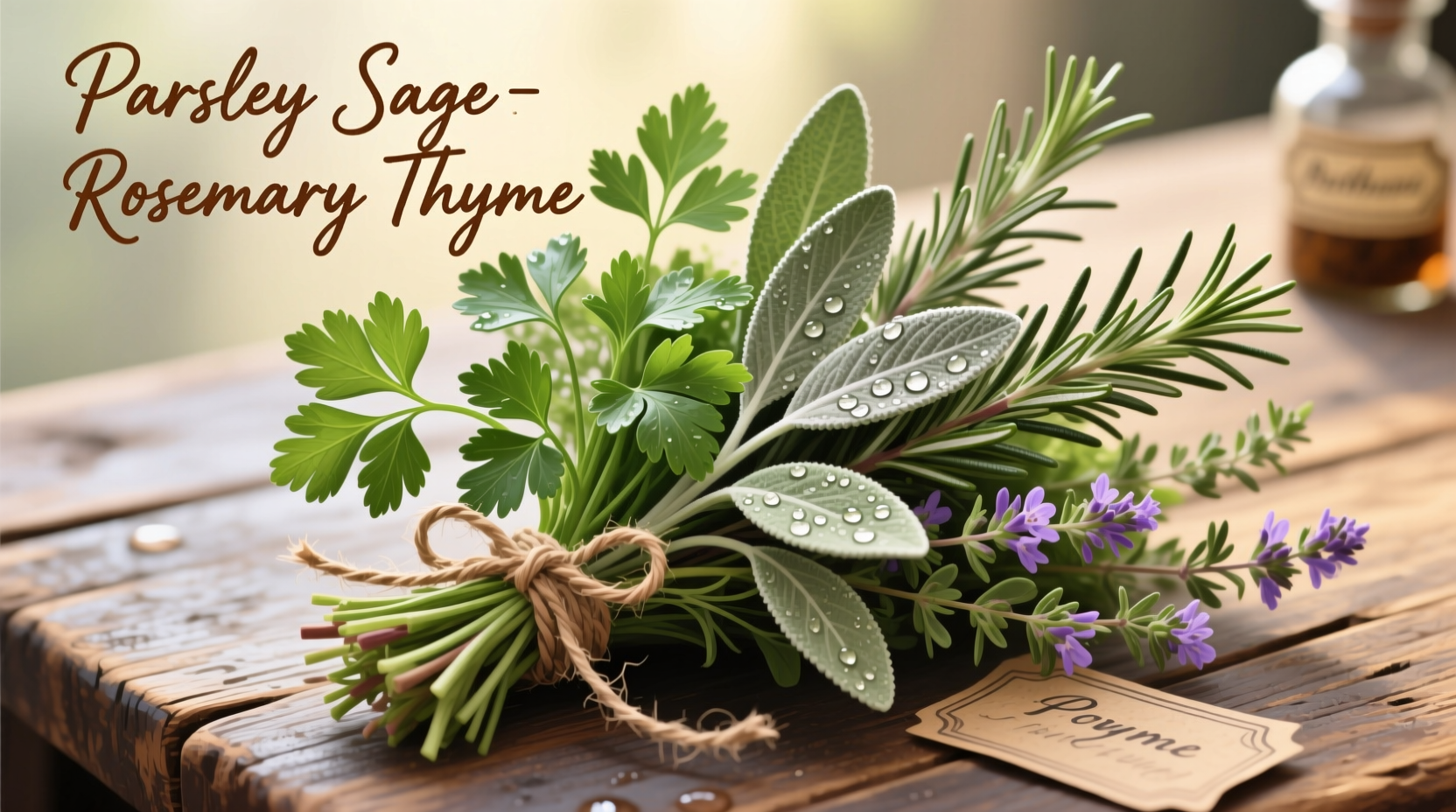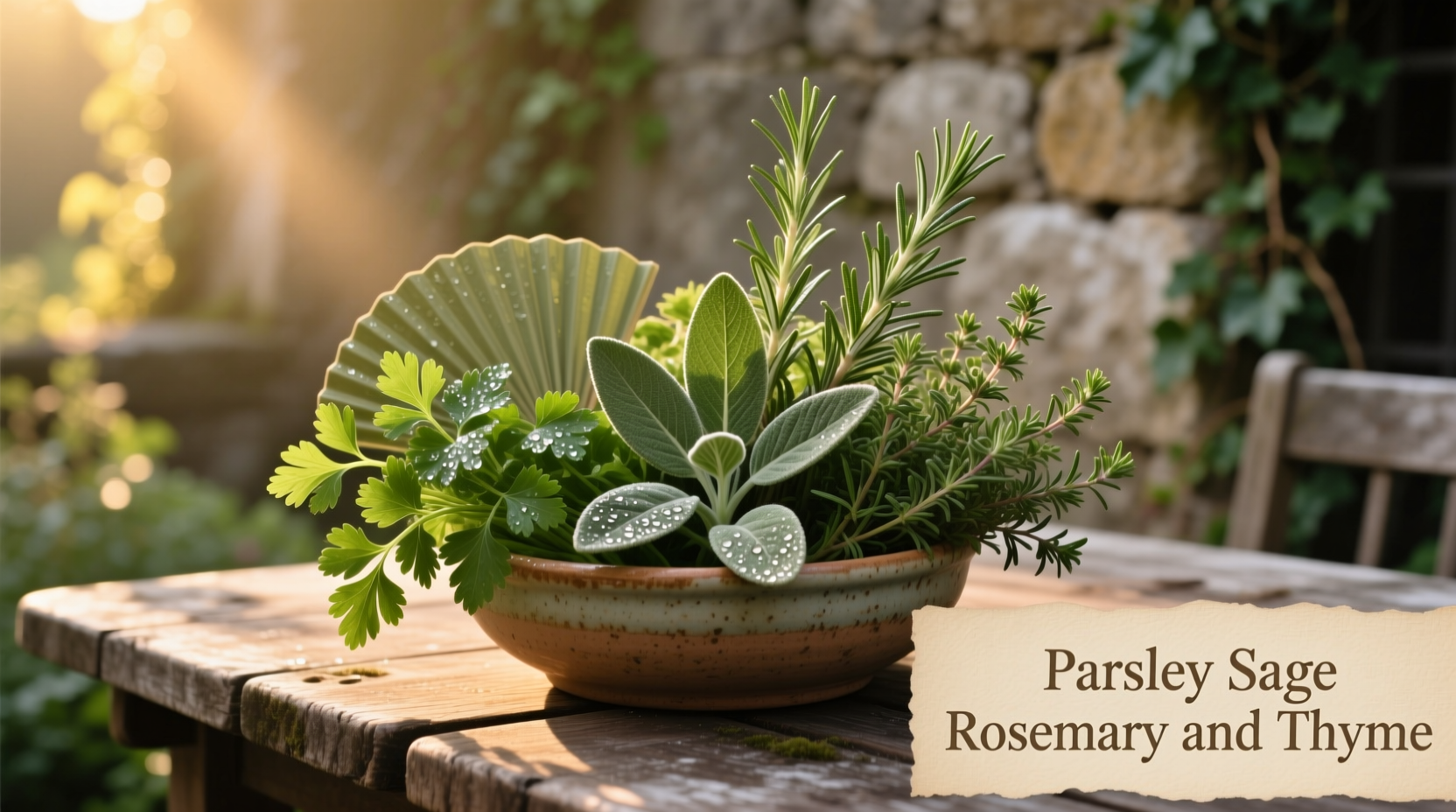The Enduring Power of This Classic Herb Quartet
When you combine parsley, sage, rosemary, and thyme in your cooking or garden, you're connecting with culinary traditions that span hundreds of years. This specific grouping isn't random—it represents a carefully balanced ecosystem of flavors and growing conditions that work in harmony. Unlike random herb collections, these four share similar soil preferences, sunlight requirements, and culinary timing, making them practical companions both in your garden bed and on your dinner plate.
Individual Herb Profiles and Their Unique Contributions
Understanding each herb's distinct characteristics helps explain why this combination has endured through culinary history. Let's examine what makes each one essential to this quartet:
| Herb | Flavor Profile | Best Culinary Uses | Growing Requirements |
|---|---|---|---|
| Parsley | Fresh, grassy, slightly peppery | Finishing dishes, sauces, salads, garnishes | Partial shade, moist soil, annual/biennial |
| Sage | Earthy, slightly peppery, camphor notes | Rich meats, stuffing, butter sauces, beans | Full sun, well-drained soil, perennial |
| Rosemary | Pine-like, woody, slightly citrusy | Roasted meats, potatoes, breads, olive oil infusions | Full sun, sandy soil, drought-tolerant perennial |
| Thyme | Subtle mint, lemon, and earth notes | Stews, soups, marinades, roasted vegetables | Full sun, well-drained soil, perennial |
Why These Herbs Work Together So Well
The magic of parsley, sage, rosemary, and thyme lies in their complementary flavor chemistry. Food science research from the University of Copenhagen's Department of Food Science shows that these herbs contain different dominant flavor compounds that don't compete but rather enhance each other. Rosemary's camphor notes balance thyme's subtle mintiness, while sage's earthiness grounds parsley's bright freshness. This creates what chefs call "flavor layering"—where each bite reveals new dimensions rather than a single dominant taste.

Historical Journey of This Herb Combination
This specific grouping of herbs has deep historical roots that explain its enduring popularity. The timeline below shows how these four herbs became culturally linked:
| Time Period | Historical Context | Herb Significance |
|---|---|---|
| Ancient Greece & Rome | Herbs used for medicinal and ceremonial purposes | Rosemary symbolized remembrance; thyme represented courage |
| Medieval Europe | Monastic gardens cultivated "sallet herbs" | All four appeared in monastery garden records as essential plants |
| 16th-17th Century | Rise of cottage gardening traditions | These herbs were commonly planted together for practical growing conditions |
| 1960s | Simon & Garfunkel release "Scarborough Fair/Canticle" | Song popularized the phrase, connecting modern audiences to historical tradition |
Practical Culinary Applications You Can Try Today
Understanding when and how to use this herb combination transforms your cooking. Professional chefs at Le Cordon Bleu culinary institute teach that these herbs work best when added at specific cooking stages:
- Rosemary and sage—add early in cooking for roasts and stews as their robust flavors need time to mellow
- Thyme—add midway through cooking as it releases flavor gradually
- Parsley—always add at the end as its delicate flavor disappears with prolonged heat
For a simple but transformative technique, create a herbes de Provence-style blend by combining equal parts dried rosemary, thyme, and sage with double the amount of dried parsley. Store in an airtight container and use to season roasted vegetables, grilled meats, or even stirred into softened butter for an instant compound butter.
Growing Your Own Harmonious Herb Garden
These herbs thrive when planted together because they share similar growing requirements. According to horticultural research from the Royal Horticultural Society, this quartet forms a beneficial micro-ecosystem in the garden:
- Rosemary's strong scent deters pests that might attack parsley
- Sage and thyme have similar water needs, preventing over or under-watering conflicts
- Parsley's shallow roots complement the deeper roots of rosemary and sage
For best results, plant them in a sunny spot with well-drained soil. Group rosemary and thyme at the back (they need the most sun), with sage in the middle, and parsley at the front where it can get slightly more moisture. This arrangement mimics their natural growing conditions while creating an attractive, functional garden space.
When This Combination Works Best (And When It Doesn't)
While versatile, this herb quartet has specific contexts where it shines and situations where it falls short. Understanding these boundaries helps you use them more effectively:
- Ideal for: Roasted meats (especially lamb, pork, and poultry), root vegetable dishes, hearty soups and stews, rustic breads, and Mediterranean-inspired cuisine
- Limited effectiveness: Delicate fish dishes, sweet applications, Asian cuisine, and dishes requiring bright acidic notes
- Pro tip: When using with chicken, remove sage after the first 20 minutes of roasting as its strong flavor can become bitter with prolonged cooking
Preserving Your Herb Harvest for Year-Round Enjoyment
Extending the life of your fresh herbs ensures you can enjoy this classic combination beyond the growing season. Research from the National Center for Home Food Preservation shows these methods work best:
- Freezing: Chop herbs and freeze in olive oil in ice cube trays (best for rosemary and thyme)
- Drying: Hang bundles upside down in a dark, dry place (ideal for sage and rosemary)
- Herb butters: Mix chopped fresh herbs with softened butter and freeze in rolls
- Vinegar infusions: Steep herbs in vinegar for salad dressings (works particularly well with thyme)
Remember that dried herbs have more concentrated flavor—use one-third the amount of dried herbs compared to fresh in recipes. For the most vibrant flavor, add dried herbs early in cooking and fresh herbs at the end.
Connecting to Tradition Through Modern Cooking
Using parsley, sage, rosemary, and thyme together connects you to centuries of culinary wisdom. This isn't just about following a recipe—it's about understanding why certain flavor combinations have stood the test of time. When you incorporate this quartet into your cooking, you're participating in a living tradition that bridges historical knowledge with contemporary culinary practice. Start with simple applications like seasoning roasted potatoes or creating a herb-infused olive oil, and gradually experiment with more complex combinations as you develop your palate for these complementary flavors.











 浙公网安备
33010002000092号
浙公网安备
33010002000092号 浙B2-20120091-4
浙B2-20120091-4